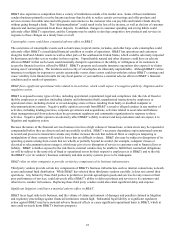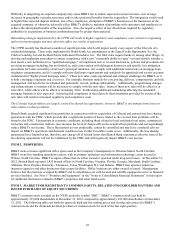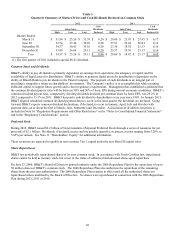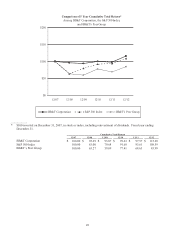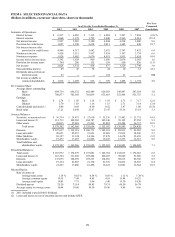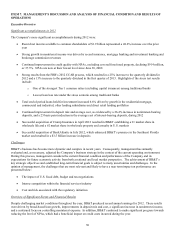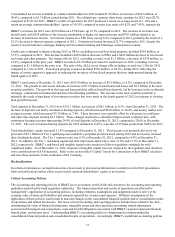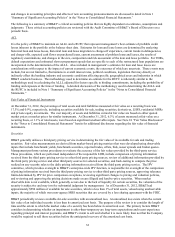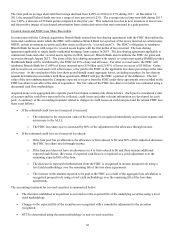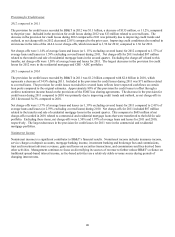BB&T 2012 Annual Report Download - page 55
Download and view the complete annual report
Please find page 55 of the 2012 BB&T annual report below. You can navigate through the pages in the report by either clicking on the pages listed below, or by using the keyword search tool below to find specific information within the annual report.
33
MSRs
BB&T has a significant mortgage loan servicing portfolio and related MSRs. BB&T has two classes of MSRs for which it
separately manages the economic risk: residential and commercial. Residential MSRs are primarily carried at fair value with
changes in fair value recorded as a component of mortgage banking income. BB&T uses various derivative instruments to
mitigate the income statement effect of changes in fair value due to changes in valuation inputs and assumptions of its
residential MSRs. MSRs do not trade in an active, open market with readily observable prices. While sales of MSRs do
occur, the precise terms and conditions typically are not readily available. Accordingly, BB&T estimates the fair value of
residential MSRs using an OAS valuation model to project MSR cash flows over multiple interest rate scenarios, which are
then discounted at risk-adjusted rates. The OAS model considers portfolio characteristics, contractually specified servicing
fees, prepayment assumptions, delinquency rates, late charges, other ancillary revenue, costs to service and other economic
factors. BB&T reassesses and periodically adjusts the underlying inputs and assumptions in the OAS model to reflect market
conditions and assumptions that a market participant would consider in valuing the MSR asset.
Fair value estimates and assumptions are compared to industry surveys, recent market activity, actual portfolio experience
and, when available, observable market data. Due to the nature of the valuation inputs, MSRs are classified within Level 3 of
the valuation hierarchy. The value of MSRs is significantly affected by mortgage interest rates available in the marketplace,
which influence mortgage loan prepayment speeds. In general, during periods of declining interest rates, the value of MSRs
declines due to increasing prepayments attributable to increased mortgage-refinance activity. Conversely, during periods of
rising interest rates, the value of MSRs generally increases due to reduced refinance activity. Commercial MSRs are carried
at the lower of cost or market and amortized over the estimated period that servicing income is expected to be received based
on projections of the amount and timing of estimated future cash flows. The amount and timing of servicing asset
amortization is based on actual results and updated projections. Refer to Note 7 “Loan Servicing” in the “Notes to
Consolidated Financial Statements” for quantitative disclosures reflecting the effect that changes in management’ s
assumptions would have on the fair value of MSRs.
LHFS
BB&T originates certain mortgage loans for sale to investors that are carried at fair value. The fair value is primarily based
on quoted market prices for securities backed by similar types of loans. Changes in the fair value are recorded as a
component of mortgage banking income, while the related origination costs are recognized in noninterest expense when
incurred. The changes in fair value of these assets are largely driven by changes in interest rates subsequent to loan funding
and changes in the fair value of servicing associated with the mortgage loan held for sale. BB&T uses various derivative
instruments to mitigate the economic effect of changes in fair value of the underlying loans.
Derivative Assets and Liabilities
BB&T uses derivatives to manage various financial risks. The fair values of derivative financial instruments are determined
based on quoted market prices, dealer quotes and internal pricing models that are primarily sensitive to market observable
data. BB&T mitigates the credit risk by subjecting counterparties to credit reviews and approvals similar to those used in
making loans and other extensions of credit. In addition, certain counterparties are required to provide collateral to BB&T
when their unsecured loss positions exceed certain negotiated limits. The fair value of interest rate lock commitments, which
are related to mortgage loan commitments, is based on quoted market prices adjusted for commitments that BB&T does not
expect to fund and includes the value attributable to the net servicing fee.
Private Equity and Similar Investments
BB&T has private equity and similar investments that are carried at fair value. Changes in the fair value of these investments
are recorded in other noninterest income each period. In many cases there are no observable market values for these
investments and management must estimate the fair value based on a comparison of the operating performance of the
company to multiples in the marketplace for similar entities. This analysis requires significant judgment and actual values in
a sale could differ materially from those estimated. As of December 31, 2012, BB&T had $323 million of these investments,
which represented less than 1% of total assets.
Intangible Assets
BB&T’ s mergers and acquisitions are accounted for using the acquisition method of accounting. Under the acquisition
method, BB&T is required to record the assets acquired, including identified intangible assets, and liabilities assumed at their
fair values, which often involves estimates based on third party valuations, such as appraisals, or internal valuations based on
discounted cash flow analyses or other valuation techniques, all of which are inherently subjective. The amortization of
identified intangible assets is based upon the estimated economic benefits to be received, which is also subjective.


